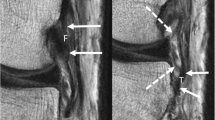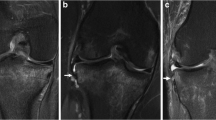Abstract
Objective
To evaluate the correlation between anterior cruciate ligament (ACL) tear and straightened, vertically oriented lateral collateral ligament (LCL).
Materials and methods
This study included 556 patients who underwent MRI of the knee and were divided into three subsets based on ACL morphology. Subset 1 included patients with unequivocal normal ACL. Subset 2 included patients with unequivocal ACL tears. Subset 3 included patients with doubtful ACL who underwent arthroscopy. MR images were reviewed and sensitivity and specificity of vertically oriented LCL as an indirect sign of ACL tear were calculated.
Results
The MRI results were as follows: subset 1, out of 282 patients, 270 had oblique LCL and 12 demonstrated vertical LCL; subset 2, out of 212 patients, 189 demonstrated vertical LCL and 23 revealed oblique LCL; subset 3, out of 62 patients, 28 patients with vertical orientation of LCL had a possible ACL tear. Patients with oblique LCL orientation (34) were reported as probably having normal ACL. On comparison with arthroscopy, in 28 patients who we reported as having possible ACL tears, there were 17 patients with torn ACL. The rest of the 11 patients revealed no ACL tears. In the group of 34 patients in whom we reported possible normal, arthroscopy-confirmed tear in 5 patients. Sensitivity and specificity of vertical LCL as an indirect sign of ACL tear was found to be 88% and the specificity 92.85%.
Conclusion
Vertically oriented LCL is a useful indirect MRI sign of ACL tear and aids in making a diagnosis, when ACL appearance is equivocal.



Similar content being viewed by others
References
Duthon VB, Barea C, Abrassart S, Fasel JH, Fritschy D, Menetrey J. Anatomy of the anterior cruciate ligament. Knee Surg Sports Traumatol Arthrosc. 2006;14:204–13.
Boden BP, Dean GS, Feagin Jr JA, Garret Jr WE. Mechanisms of anterior cruciate ligament injury. Orthopedics. 2000;23:573–8.
Cohen SB, Van Beek C, Starman JS, Armfield D, Irrgang JJ, Fu FH. MRI measurement of the 2 bundles of the normal anterior cruciate ligament. Orthopedics. 2009;32:687.
James LJ, Connell DA. The vertically oriented fibular collateral ligament:a secondary sign of anterior cruciate ligament rupture on magnetic resonance imaging. Eur Radiol. 2006;16:1854–6.
Chan WP, Peterfy C, Fritz RC, et al. MR diagnosis of complete tears of the anterior cruciate ligament of the knee: importance of anterior subluxation of the tibia. Am J Roentgenol. 1994;162:355–60.
Barry KP, Mesgarzadeh M, Triolo J, et al. Accuracy of MRI patterns in evaluating anterior cruciate ligament tears. Skelet Radiol. 1996;25:365–70.
Tung GA, Davis LM, Wiggins ME, et al. Tears of the anterior cruciate ligament: primary and secondary signs at MR imaging. Radiology. 1993;188:661–7.
Kelly EA, Berquist TH. MRI of musculoskeletal system. 5th ed. Philadelphia: Lippincott Williams and Wilkins; 2005. p. 303–422.
Funding and grants
None.
Conflict of interest
None.
Disclosures
None.
Author information
Authors and Affiliations
Corresponding author
Rights and permissions
About this article
Cite this article
Palle, L., Reddy, B. & Reddy, J. Sensitivity and specificity of vertically oriented lateral collateral ligament as an indirect sign of anterior cruciate ligament tear on magnetic resonance imaging. Skeletal Radiol 39, 1123–1127 (2010). https://doi.org/10.1007/s00256-010-0924-2
Received:
Revised:
Accepted:
Published:
Issue Date:
DOI: https://doi.org/10.1007/s00256-010-0924-2




